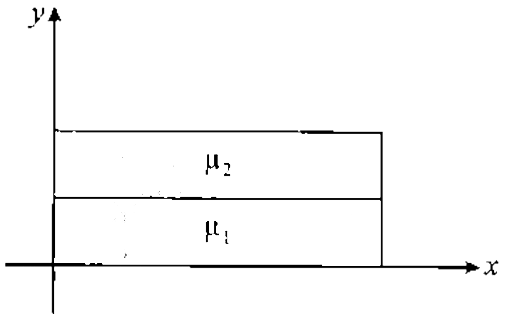Two thin slabs of refractive indices μ1 and μ2 are placed parallel to each other in the x-z plane. If the direction of propagation of a ray in the two media are along the vectors →r1=aˆi+bˆj and →r2=cˆi+dˆj then we have:

μ1a=μ2c
μ1(a2+b2)=μ2(c2+d2)
μ1a/√a2+b2=μ2a/√c2+d2
None of these
The correct Answer is:A
For parallel composite slab
μsinθ=constant
μ1×a√a2+b2=μ2×c√c2+d2
∵|ˆr1|=|ˆr2|=1∴(√a2+b2=√c2+d2=1)
∴μ1a=μ2c
_E01_059_S01.png)
Topper's Solved these Questions
- GEOMETRICAL OPTICSBOOK - ALLENCHAPTER - GEOMETRICAL OPTICSEXERCISE - EXERCISE-3
12 Videos
- GEOMETRICAL OPTICSBOOK - ALLENCHAPTER - GEOMETRICAL OPTICSEXERCISE - EXERCISE-04[A]
23 Videos
- GEOMETRICAL OPTICSBOOK - ALLENCHAPTER - GEOMETRICAL OPTICSEXERCISE - EXERCISE- 01
45 Videos
- CURRENT ELECTRICITYBOOK - ALLENCHAPTER - CURRENT ELECTRICITYEXERCISE - EX.II
66 Videos
- GRAVITATIONBOOK - ALLENCHAPTER - GRAVITATIONEXERCISE - EXERCISE 4
9 Videos
Similar Questions
The xz plane separates two media A and B with refractive indices μ1 & μ2 respectively. A ray of light travels from A to B. Its directions in the two media are given by the unit vectors, →rA=aˆi+bˆj & →rB=αˆi+βˆj respectively where ˆi & ˆj are unit vectors in the x & y directions. Then :
View SolutionThe xz plane separates two media A and B with refractive indices μ1 & μ2 respectively. A ray of light travels from A to B. Its directions in the two media are given by the unut vectors, →rA=aˆi+bˆj & →rBαˆi+βˆj respectively where ˆi & ˆj are unit vectors in the x & y directions. Then :
View SolutionThe x-z plane separates two media A and B of refractive indices μ1=1.5 and μ2=2. A ray of light travels from A to B. Its directions in the two media are given by unit vectors u1=aˆi+bˆj and u2=cˆi+aˆj. Then
View SolutionGiven two vectors →a=−ˆi+2ˆj+2ˆkand→b=−2ˆi+ˆj+2ˆk
find ∣∣→a×→b∣∣
View SolutionThe vector →c, directed along the internal bisector of the angle between the vectors →a=7ˆi−4ˆj−4ˆkand→b=−2ˆi−ˆj+2ˆk with |→c|=5√6, is
View SolutionFor what value of x , will the two vector A=2ˆi+2ˆj−xˆkandB=2ˆi−ˆj−3ˆk are perpendicular to each other ?
View SolutionIf two vectors are given as →a=ˆi−ˆj+2ˆk and →b=ˆi+2ˆj+ˆk, the unit vector perpendicular to both vec a and vec b is
View SolutionA plane is parallel to the vectors ˆi+ˆj+ˆk and 2ˆk and another plane is parallel to the vectors ˆi+ˆj and ˆi−ˆk. The acute angle between the line of intersection of the two planes and the vector ˆi−ˆj+ˆk is
View SolutionA force acting on a body displaces it from position vector →r1=(2ˆi−ˆj+3ˆk)m to →r2=(5ˆi−2ˆj+4ˆk)m. Then find the displacement vector.
View SolutionThe vector parallel to the line of intersection of the planes →r.(3ˆi−ˆj+ˆk)=1 and →r.(ˆi+4ˆj−2ˆk)=2 is :
View Solution
